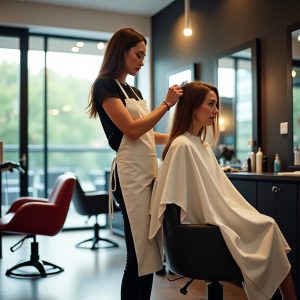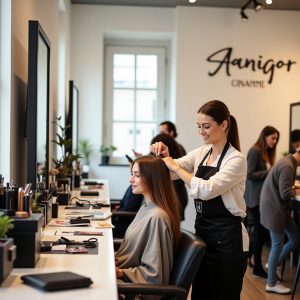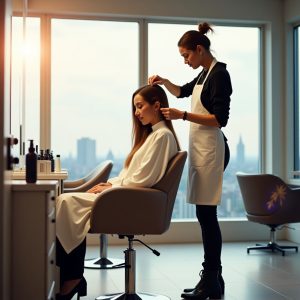Hair style
Hair style plays a significant psychosocial function in life, by affecting personal self-image and aiding in the formation of interpersonal bonds. Though it is a physical characteristic, it’s easy for us to alter its length, color, and form by utilizing an array of various hair styling cosmetic products found on the market. In structure, short hair cut consists of a mesh-like arrangement of keratin, which is coiled by ionic forces, hydrogen bonds, van der Waals forces, and disulfide bonds for the α-helices.
 The weak bonds can be broken and remade readily by merely styling hair when wet, but this new form is temporary. To permanently alter the hair shape so that it lasts for several washes with shampoo, one has to reorganize the disulfide bonds through the reduction and reformation of new disulfide bonds by perming and relaxing solutions.
The weak bonds can be broken and remade readily by merely styling hair when wet, but this new form is temporary. To permanently alter the hair shape so that it lasts for several washes with shampoo, one has to reorganize the disulfide bonds through the reduction and reformation of new disulfide bonds by perming and relaxing solutions.
The permanent waving is usually a two-stage process, depending on the action of reducing agents, thioglycolates or bisulfites, followed by an oxidative agent, usually hydrogen peroxide.
This process encourages the elimination of the hydrophobic top-layer of the cuticle the appearance of cracks the lifting of cuticles the appearance of split ends and changes in hair style texture, hydration and gloss. Apart from the harmful effect on the quality of the hair fibers, most of the products employed in perming contain toxic chemicals, with an adverse effect on human life and environment. Such chemicals can be alkaline agents, thioglycolates, guanidine and even formaldehyde.
The growing awareness regarding health and the environment globally has fostered the use of green formulas to substitute the toxicity of today’s perming processes. Creating new green hair cosmetic products is envisioned as the best substitute for the products offered in the market, which typically consists of chemicals. Some nontoxic hair style perming formulations have already been devised to replace the existing perming formulations.The alternative suggested by Cruz et as, relies on the utilization of keratin decapeptide sequences obtained from the human keratin genome . short hair styles .
These peptides substitute the damaging alkaline reductive solutions, reducing or even eliminating the harm inflicted on the hair fibers by chemical products . In Song et al, the ability of the cysteine and the poly carboxylic acids to replace the thioglycolates and the hydrogen peroxide was proven, respectively. Cysteine, a thiol-containing amino acid with high reducibility, reduces the disulfide bonds, whereas the poly carboxylic acids, which are known to be able to crosslink various protein materials, facilitates the creation of new disulfide bonds .
 Materials and Methods
Materials and Methods
Asian hair style. The chosen proteins have various structures and characteristics which may affect the modeling ability of the protein. Serum albumin is the most common protein found in mammal plasma and performs a number of significant functions. Specifically, BSA is a multi-functional protein with an excellent ligand binding ability, possessing the ability to transport a range of metabolites. Silk fibroin is derived from silkworm Bombyx more and is composed of two chains and L-fibroin light with 26 kDa linked by a disulfide bond .
best long hair. The SF is rated as nontoxic and biocompatible and exhibits excellent water binding and absorptive properties, making this protein suitable for applications in cosmetics . Keratin proteins are a large category of insoluble proteins present in the hair style, constituting over 75% of his weight and containing 7–20% cystine and α-helix structure . Because of its excellent mechanical and protective features, keratin is extensively investigated for the creation of cosmetic products. hair, proteins, perming efficiency, perming resistance, green formulations. Keratin and mainly keratin hydrolysates have been widely used in personal care and hair care products. KP-UM is a chromogenic fusion protein capable of staining and enhancing the mechanical properties of hair.
Fusion Proteins
hair style KP-UM protein also changes color with respect to polarity and pH in the solution used to resuspend it. Regardless of the formulation, KP-UM protein can color overbleached hair at the cuticle and cortex level and enhance the mechanical quality of hair. Materials and Methods Natural Asian, black hair samples were obtained from International Hair Importers & Products Inc. A local hairdresser donated the hair samples that were used for keratin extraction. The KP-UM and KP-Crist genes were codon-optimized through Gen Script and cloned into the pET-28 a plasmid. Nickel magnetic beads for purification of proteins were obtained from Gen Script.
The silk fibroin was isolated from Bombyx more cocoons kindly donated by Dr. Silvia Cappe llozza from Semitone Specialization per la Bachi coltura’. The BSA protein was obtained from Merck. Culture medium was bought from Grips, Portugal, and detergent compatible DC protein assay kit from Bio-Rad, Portugal. All other chemicals were provided by Merck. Keratin Extraction and Purification Keratin proteins were isolated from donated best human hair received from a local hairdresser. Following removal of the contaminants and lipids from hair as per the IAEA/RL/50 1978 guidelines, the keratin was isolated using a method modified from Ayutthaya et al .
Keratin Extraction
Hair style The keratin solution was subsequently dialyzed at room temperature for 5 days against distilled water using a dialysis membrane with a cutoff of 14 kDa. Silk Fibroin SF Extraction and Purification 5 g of Bombyx moori cocoons were soaked in 1 L of boiling 0.05 M Na2CO3 solution for 10 min. Na2CO3 solution was replaced multiple times until cocoons fragmented completely.
The degummed silk fibroin SF was dried at 40 °C and dissolved using a solution of 9.3 M lithium bromide at 60 °C . The soluble SF was filtered to be free of undissolved fibers and dialyzed for 5 days in distilled water with a dialysis membrane of 14 kDa cutoff. best Hair style Perming with Keratin, KP-UM, SF, BSA and KP-Crist Proteins.
The virgin hair style from Asia was pretreated for enhancing the binding of the proteins to the hair style. before protein application and boys hair styling. The hair style was towel-dried and 2 mL of the protein solutions 1 mg/mL in phosphate buffer pH 5, 7 or 9 was applied over the hair for 20 min.

The ethanolic formulation were incubated after pretreatment with phosphate buffer at pH 5, 7 and 9 without the proteins. A commercial Bayless, which had been preheated at 200 °C, was applied for 50 s to curl the treated hair meshes.
This duration was regarded as the duration required for the hair to dry and to develop a curly shape. In order to compare the initial results, all of the hair style meshes were curled the same number of times and in the same direction on the Bayless . Perming Efficiency The perming efficiency of curled Asian hair style was assessed after application of Babyish and through six wash cycles, with tap water and a commercial shampoo. The wash cycles were conducted without modifying the pH of the wash solution . The meshes were air-dried at room temperature after washing and the perming efficiency was measured when the meshes were thoroughly dried.
In comparison, a commercial perming lotion water, ammonium thioglycolate, ammonium bicarbonate, ethanolamine, PEG-40 hydrogenated castor oil, cocami dopropyl betaine, ammonium hydroxide, polyquaternium-7, simethicone, styrene/vp copolymer and tetra sodium EDTA and a neutralizer was chosen as a control. The perming efficiency was determined by using the following equation.
Result
The hair styling process employs aggressive chemicals that impact human health and the environment. In this research, we investigated BSA, silk fibroin, keratin, KP-UM and KP-Crist proteins as novel perming agents. The perming efficiency of hair style treated using these proteins was compared to the outcome of a commercial product chemical treatment. Irrespective of the pH of the formulation, all the proteins were capable of altering hair shape. The perming efficiency of the proteins in styling the hair style, which was a measure of their capability, depended upon the amino acidic sequence, size, conformation, charge, and capability to bind the proteins to the hair fiber as well as to the hair proteins.
Although the most efficient perming was found for the chemical treatment, the perming efficiencies of keratin and BSA were also impressive with values around that determined for the chemical treatment. In addition, all of the proteins remarkably enhanced the fiber’s external and internal water content due to the interaction and binding of the proteins with water molecules. The water content increases can inhibit damage to the hair during hair styling processes using high temperatures.

